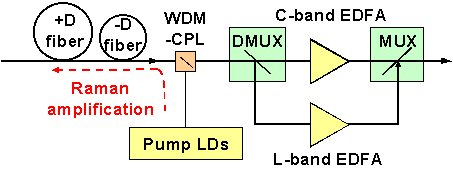September 25, 2000 --- Fujitsu Laboratories Ltd. has successfully completed the world's first 7,200-kilometer transmission experiment using the multi-terabit optical dense wavelength division multiplex (DWDM) communications technology that will support the larger-capacity and higher-speed Internet of the future. This development is expected to enable trans-Atlantic transmission (over 6,500 kilometers) using a single optical fiber with 211 wavelength channels-each providing 10 gigabits per second data transmission for a total of 2.11 terabits/second. In addition, by adopting Raman amplification*1, Fujitsu was able to extend the repeater spacing from the former 50 kilometers to 80 kilometers, enabling a significant reduction in the number of optical repeaters. Fujitsu presented details of its development on September 7 at the European Conference on Optical Communication in Munich, Germany.
Development Background
The spread of the Internet is bringing global-scale changes to the way companies do business and people's lifestyles, and the worldwide demand for greater communications bandwidth and speed needed to take full advantage of the Internet is increasing by leaps and bounds. Since data transmission capacity increases in proportion to the number of wavelengths transmitted, dense wavelength division multiplexing (DWDM)-which enables the transmission of multiple optical wavelengths over a single optical fiber-has emerged as a key enabling technology to meet this demand. However, in the case of trans-oceanic long-distance transmission systems, a major challenge has been how to achieve large transmission capacity while extending repeater spacing. In order to assure a given signal-to-noise (S/N) ratio in a single stream of light, the optical amplification repeaters need to have a high output. On the other hand, in order to decrease the waveform distortion caused by the fiber non-linear effect*2, the light output from the optical amplification repeater must be decreased, and the trade-off between the two requirements has been a major obstacle. Raman amplification, a transmission method that offsets fiber loss, had been proposed to deal with this problem, but until now it has not been successfully incorporated into broadband technology appropriate for DWDM long-haul transmission. Accordingly, the world record in previous transmission experiments stood at a total distance of 7,000 kilometers at 1.8Tb/s with a repeater spacing of 50km.
Technology Overview
By developing a new Raman amplifier that can be applied to broadband optical transmission and combining it with a hybrid fiber with high Raman gain efficiency, Fujitsu was able to develop a DWDM system that allows both broadband and long-distance transmission.
Specific features of the new technology follow:
- Broadband optical amplifier
By making use of an excitation, i.e., pumping light for the Raman amplifier in multiple wavelengths while optimizing wavelength and optical power, a flat and uniform amplification was made possible in broad wavelength bands. And by combining the new Raman amplifier with an existing 1550nm/1580nm band optical fiber amplifier, Fujitsu was able to achieve simultaneous amplification of 211 wavelength channels, combining 103 in the 1550nm band and 108 in the 1580nm band using a 37.5GHz (0.3nm) wavelength spacing.
- Broadband fiber
Utilizing fibers having two different characteristics between the optical amplifiers resulted in a system suitable for broadband. Specifically, Fujitsu adopted a hybrid fiber, comprising an optical fiber with a large core diameter and low loss at the front portion of the interval between repeaters and, in the back portion, one able to compensate for the dispersion of each wavelength-a factor in waveform distortion. This approach made high Raman gain possible as well as a broad bandwidth of 72nm (9THz when computed in terms of optical frequencies).
Fig. 1: WDM Optical Fiber Amplifier

Fujitsu conducted an experiment using the aforementioned new technology and was able to transmit a 2.11-terabit/second data signal over a distance of 7,200 kilometers, sufficient for direct trans-Atlantic transmission. In addition, the repeater space was increased by about 1.6 times to 80km, reducing the number of repeaters significantly, from 144 units to 90 units.
Previously, Fujitsu has succeeded in demonstrating an actual 640Gb/s optical submarine cable system that multiplexes 64 channels of 10Gb/s transmission. Capitalizing on the results of this latest experiment, Fujitsu intends to move ahead with development efforts to commercialize trans-oceanic optical transmission systems with even greater capacity and longer intervals between repeaters.
Notes
- Raman amplification
A technology that uses a pumping light in the 1400nm band to amplify a 1500nm band light signal through application of Raman effect, which is a fiber nonlinear effect of the optical fiber. The technology also has found some practical application in non-repeater transmission systems.
- Nonlinear effect
Nonlinear effects in optical fibers originate from vibrational excitation of the fiber's silica material and are related to the intensity dependence for the refractive index. Particularly for long-haul transmission systems over 1,000 km and more than 100 WDM channels, accumulated nonlinear effects can lead to waveform distortion and crosstalk between WDM signals. The generation of nonlinear effect and the problems arising from it are closely related to chromatic dispersion in optical fibers. Therefore, dispersion management is very important.
About Fujitsu
Fujitsu Limited (TSE: 6702) is a leading provider of Internet-based information technology solutions for the global marketplace. Comprising over 500 group companies and affiliates worldwide -- including ICL, Amdahl and DMR Consulting -- it had consolidated revenues of 5.26 trillion yen ($49.6 billion) in the fiscal year ended March 31, 2000. Fujitsu's pace-setting technologies, world-class computing and telecommunications platforms, and global corps of over 60,000 systems and services experts make it uniquely positioned to unleash the infinite possibilities of the Internet to help its customers succeed. Altogether, the Fujitsu Group has 188,000 employees and operations in over 100 countries. Internet: http://www.fujitsu.com/
Founded in 1968 as a wholly owned subsidiary of Fujitsu Limited, Fujitsu Laboratories Limited is one of the premier research centers in the world. With five laboratories in Japan and one in the United States, the organization conducts a wide range of basic and applied research in the areas of Multimedia, Personal Systems, Networks, Peripherals, Advanced Materials and Electronic Devices.
|